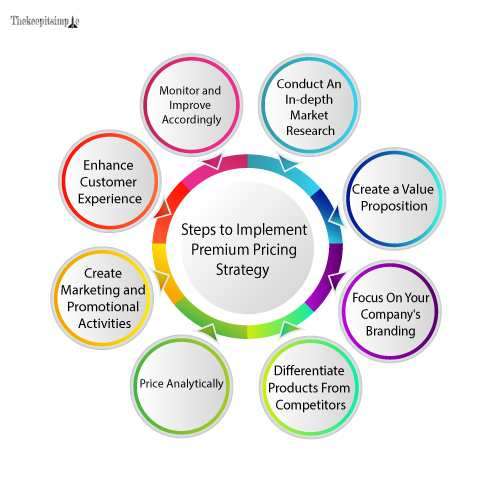In this era of diverse companies and startups, every brand needs to set up its roots in any segment to sustain itself in the industry. Among all the segments, the premium pricing strategy is one of the best as it enhances your brand image and registers more profit for your company.
In this premium price strategy, you set up your brand as a luxurious or premium authority in the market to charge higher prices for providing a premium experience. This strategy is not only about charging higher prices, but it has several other essential factors before implementing it.
From “What is premium price strategy” to “How you can implement it”, we will discuss every essential factor in this article.
What is Premium Pricing?
Premium Pricing refers to a strategy where companies set their products or services’ pricing higher than the competitors in the market. It helps companies to set a premium, luxurious, and exclusive perception of their products and services in the customer’s mind. This strategy is for a premium audience, who can pay higher for better quality products.

Generally, companies with a storing brand value, quality features, helpful customer support, and value-for-money experience offer a successful premium price strategy. The companies with the premium pricing strategy build their exclusive image in the market. It helps them generate more industry profit margins.
However, the premium pricing strategy can not apply to all companies unless you can justify your prices with the benefits you’re providing to the customer. You would also face the competitive pricing of your industry competitors to ruin your price positioning in the market. Thus, before applying the premium pricing strategy to your company, you should properly research the market and your competitors, better understand customer preference, and try to mold your brand image in that way gradually.
8 Simple Steps to Implement Premium Pricing Strategy

Step #1: Conduct An In-depth Market Research
First, you must conduct market research and understand your target market, audience and industry competitors. It would help if you determined whether your target customers are interested in exclusive products and pay higher prices.
Step #2: Create a Value Proposition
Suppose your customers are willing to pay premium prices for exclusive products or services. In that case, you have to create compelling products or services by adding high-end features and exclusive experiences. It showcases your product as superior value.
Step #3: Focus On Your Company’s Branding or Positioning
To implement the premium pricing strategy, you must build a strong brand image for your company. You have to design your packaging and materials and develop creative marketing messages to make your brand perceived as a premium product.
Step #4: Differentiate Your Product/Service From Your Competitors
To properly shift your products into the premium segment, you have to differentiate your products/services from your competitors in a positive way, just like Apple. Simply, you must deliver better features, more quality, helpful and friendly customer support, and a premium experience through your product/service. It will justify your premium prices in a very competitive market.
Step #5: Price Analytically
Now, thoroughly analyze your cost, customer perception towards your brand, and competitive landscape. Also, do not forget to look at your customers’ production cost, profit margins, product value, and price sensitivity. Then, decide the price of your products and services.
Step #6: Create Marketing and Promotional Activities
It would help if you created some effective marketing and promotional strategies to show up your brand’s premium offering. Take the help of advertising, social media marketing, content marketing, and more. It will help you create brand awareness and position your brand image in the premium segment.
Step #7: Enhance Customer Experience
To charge premium pricing providing a premium feel or experience to your customers through your brand is essential. You can simply do it by providing fantastic customer service, one-to-one interaction, premium packaging and presentation while delivering your product or service to your customer.
Step #8: Monitor and Improve Accordingly
Ultimately, you must continually monitor your target market, product feedback, and sales performance. You should make all the improvements required to make your product relevant and competitive in your industry.
Real-Life Example of Premium Pricing Strategy
Example #1: Rolex
Rolex is one of the prominent brands widely using the premium pricing strategy, relying upon its premium designs and higher product value. Even after any watch shows a time, Rolex has created its value in the market that showcases the richness and royalty of the people who wear it. Therefore, they have established themselves as a big brand in the industry.
Example #2: Apple
Apple is the best example of a premium pricing strategy. They launched their iPhones at exceptionally higher prices, but they went out of stock very soon. All the iPhone provides to its audience is premium-ness and luxury. Therefore, Apple is at the top worldwide in the market cap.
Example #3: Salesforce
Salesforce is one of the few SaaS-based companies that knows “what is premium price strategy?” They have also included a premium pricing strategy option in their plans. They offer users luxurious and highly reliable CRM support at exceptionally higher prices. However, the audience happily purchases this premium service. It helps them enjoy a premium service with its exceptional value.
Pros and Cons of Premium Price Strategy
Pros:
- Increased profit margins: It allows your brand to have higher profit margins, as you get higher profit per unit sold.
- Enhance brand image: It also helps enhance your company’s brand image among the customers.
- Make you superior in the Industry: It makes you a royal and industry-leading brand. Therefore, it doesn’t let you compete but rule in the market.
Cons:
- Must have a USP: It is essential to have your brand product’s or service’s USP (Unique Selling Point). It will defer your brand from market competitors and justify your premium prices.
- Limit your sales: Premium pricing has a limited customer segment that doesn’t allow you to sell to all types of customers. However, they are die-hard fans of the premium items in the market.
- Doesn’t allow you to compete: It doesn’t leave any hope for you to cut down your prices to compete with the market. Being a premium brand, you always have to maintain your prices no matter if you go into a loss.
When Businesses Use Premium Pricing?
A company needs to fulfill several conditions to implement the premium pricing strategy. You should have a strong customer base and brand loyalty before lowering your prices to the premium segment. It would always let you have an assurity of certain loyal buyers to at least meet your break-even at the start of a premium journey.
This brand loyalty also helps you grow your reputation through word-of-mouth. Here, your loyal customers will tell other buyers about the luxurious experience of your brand. This phenomenon is generally called brand equity.
Frequently Asked Questions (FAQs)
What is premium pricing and its example?
Premium pricing refers to setting up higher prices for your product or service. It provides a premium experience in exchange. You must deliver higher quality products, unique features, and a premium experience. The best example of a company using a premium pricing strategy is Apple.
What are the 4 pricing strategies?
Generally, there are four types of pricing strategies:
- Value-based pricing
- Competitor-based pricing
- Cost-plus pricing
- Dynamic pricing
Among all these strategies, you have to choose the best fit for your company based on your goals and objectives.
What is the premium pricing strategy kotler?
According to Philip Kotler, Premium pricing refers to charging comparatively a lot higher prices and delivering the best possible quality to set your brand as a premium or luxurious brand in the market.
To Wrap Up
In conclusion, we would say that a premium pricing strategy should only be implemented for a company with a fantastic brand image and loyal customer base. It would help you set up as a leader in the industry, just like Apple, Rolex, and Rolls Royce. So, now it’s your time to implement this strategy and start your royal journey from today.